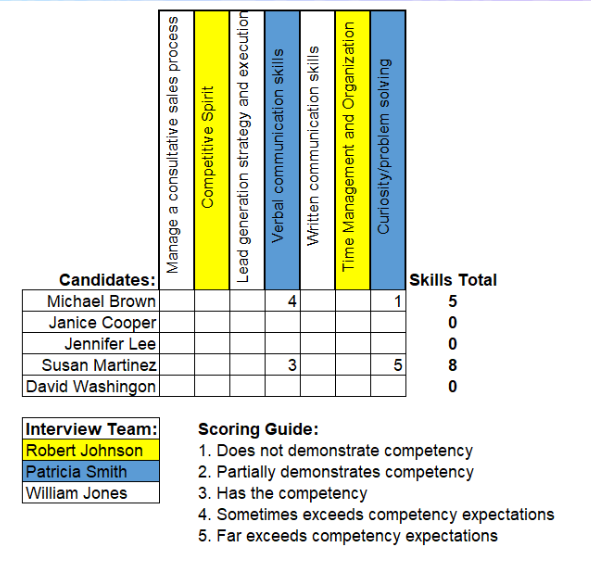
The February Frenzy: How to Hire Top Sales Talent

1. Document Performance Objectives and Key Competencies
Before you start interviewing, it’s crucial to define the role’s performance objectives and key competencies. These are two different things! Performance objectives are the specific, measurable goals the seller will be held accountable for, such as achieving a certain quota or closing a specific number of deals – while the key competencies are the skills someone needs to be able to achieve those objectives.
- Forecast Accuracy: The seller will be expected to forecast their monthly and quarterly business with 90% accuracy.
- Competitive Drive: The ability to thrive in a competitive environment and win deals against established players.
- Consultative Selling: The ability to lead a consultative sales process, understanding customer needs, and positioning solutions effectively.
- Lead Generation: The ability to develop and execute effective lead generation strategies in a company that has little SDR support.
- Communication Skills: Excellent verbal and written communication skills, including presentation skills.
I’ve learned from exeprience that both are important to talk about in the recruitng process. It’s easy to look at a past history of objective attainment and conclude “this seller was alwas at 120% of their quota in their last company, so they’re going to do well at mine, too.” However, the candidate may have succeeded there because they had a wide network of referenable customers and a strong marketing team that generated 80% of their pipeline. If the current role is at a startup with a small install base and little marketing support, that top performer may not have the competency (or interest) in succeeding in our new specific situation.
2. Write a Compelling Job Description
With the performance objectives and competencies clearly defined, you can craft a job description that attracts the right candidates. The job description should include:
- Company Overview: A brief description of your company, its culture, and values.
- Position Summary: A concise overview of the role and its responsibilities.
- Key Objectives: A list of the specific, measurable goals the seller will be accountable for.
- Key Competencies: A detailed description of the skills and abilities required for success in the role.
- Additional Requirements: Any other necessary qualifications, such as education or experience.
- Benefits: A summary of the compensation and benefits package offered.
3. Conduct Structured Interviews
To avoid being swayed by a candidate’s charm or personality, it’s essential to conduct structured interviews that assess each candidate against the predefined competencies. This involves:
- Asking Behavior-Based Questions: Use questions that start with “Tell me about a time when…” to uncover examples of the candidate demonstrating the required competencies in real-life situations.
- Standardizing Interview Questions: Ask the same questions in the same way across all candidates to ensure consistency and allow for accurate comparisons.
- Testing All Required Competencies: Structure the interview process to ensure that every required competency is thoroughly assessed.
- Creating an Interview Scoring Grid: Develop a grid that lists the key competencies and allows interviewers to score each candidate on a scale of 1 to 5.

4. Make a Timely Offer
As soon as you’ve identified a candidate who has scored 3 or above on all competencies, MAKE THAT OFFER! By definition, you’ve found someone who has all of the competencies you’ve identified will be needed to succeed in the job. Any further action – to have the candidate interview with more colleagues, for you to see more candidates, whatever – is just adding delay into the process.
During those extra days of delay, it’s possible that your qualified candidate will continue to interview with other companies and accept a role somewhere else – further extending your timeline for finding another candidate that has everything you’re looking for. Every day that a quota-carrying role remains open represents potential lost revenue, and only delays the time it will take for your to onboard and ramp a new seller. And that just puts you further and further away from achieving your goal for the year.
5. Keep Other Candidates In the Process
Just because you’ve extended an offer, you shouldn’t stop interviewing other candidates. Your preferred candidate may decline the offer. Increasingly, candidates are accepting roles, and then just failing to show up for the first day of work.
By continuing to interview to interview candidates until your chosen one starts their first day on the job, you’re ensuring you’ve maintained momentum toward having a fully-staffed team at all times – and you’re maintaining a network of folks you might want to turn to for future openings, as well.
6. End Unproductive Interviews
By the same token, you should end the process with candidates as soon as you determine that they’re misssing a key competency. Unless you’re confident that you will be able to train them to overcome a key deficiency, they will not succeed in your role. It’s simply a waste of time, then, to continue to interview candidates that you know are not suitable for the job.
The bravest interviewers will end the interview as soon as they’ve found this fatal flaw – and candidly explain why there’s not a good match to be had.
Everyone, though, should cancel the rest of the slate of interviews – saving the interview team and the candidate hours of time in conversations you’ve determined will not result in an offer.
7. Remember: There’s No Perfect Candidate
It’s important to remember that there’s no perfect candidate. Every seller will have strengths and weaknesses, and every manager will have skills they’re able to develop on their teams, and skills they’re not able to improve. The goal is to find the candidate who best fits your needs and has the potential to succeed with the support and coaching you provide.
































